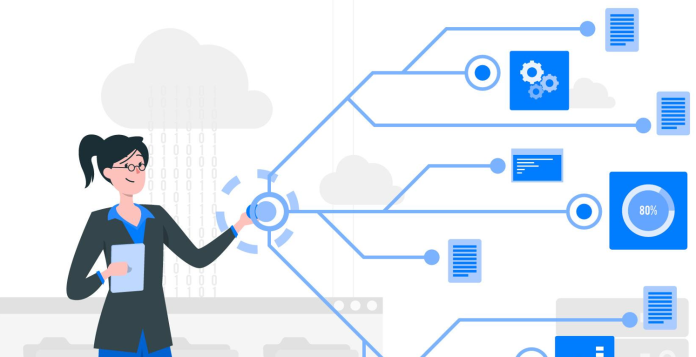There are many benefits of using microservices, and this is the reason why every modern IT organization is adopting them. The content provided by Netflix can be accessed through multiple devices, and this feat is achieved through microservices. Other popular companies are using them for development-related works. For example, Twitter. Companies leveraging microservices can follow the latest developmental trends and keep up with the development pace. No doubt that microservices have become a key component of digital transformation.
Are microservices the evolution of SOA or (service-oriented architecture)? Different questions come into one’s mind. So, it is essential to have detailed information about them. The management of APIs is completely different from the management of microservices. However, APIs are used to expose microservices for scaling purposes.
What is Microservices?
Microservices are developmental techniques used for software scaling; these methodologies are further organized for executing specific business functions. Business capability can be restructured for the scaling of applications.
Before delving deep into microservices and microservice architecture, tech-savvy needs to understand the role of microservice architecture. The set of methodologies is used to build software apps easily through the help of individual and small services.
There are many advantages of using the microservice architecture. The advent of this architecture helps in empowering independent or decentralized units for better innovation because it is easy to build and manage independent and small units. There are compelling features of this platform or architecture. Individual teams can work on independent services that can be easily shared through APIs. Applications can get benefitted from small services, and individual teams can work on specific units without affecting the whole system.
Microservices are deployable units that can be shared in the cloud platform. Developers deploy independent units in containers that comprise logics for running services. APIs play an important role in the development of applications that comprise services; they provide accessibility of applications from the cloud environment. Further, the interaction of microservices with different systems is solely done through APIs.
Specifically, we have known the following points about microservices:
- Independent services that are responsible for executing unique functions for business requirements.
- The small services do not affect other services during their deployment.
- They are independently deployable but can easily communicate with other microservices. An interface is used for communication between them. For example, RESTful APIs; they help in revealing services.
- The codes can be disposed of easily without affecting any other component of architecture.
They work independently and do not show compatibility with centralized systems that block assets and apply high security for functioning. Organizations using microservices have to focus on governance for security purposes. However, teams need to develop measures for security in the best way, using tools for innovation and autonomy.
How to Implement Microservices
Companies are using microservices for any type of developmental-related works like automatic integration. The deployment of services helps in facilitating iteration. Earlier, the software release cycles were arduous, but, now it has become much improved. Now, experts can work on deployments daily basis rather than monthly.
The above information clearly shows that microservices emphasize to use of technologies for innovation. They can be better applied to individual teams as compared to large teams working on similar projects. The transition takes time because it helps in empowering individuals and small teams.
The company is using the modern architecture for development-related works, eliminating the dependency on linked apps and waterfall models. Now, IT enterprises can solely rely on modern architecture, APIs, containerized applications and workforce.
Further, independent services are to be scaled for better distribution of workloads across the cloud. Therefore, microservices help in building cloud strategies. They help in building flexible platforms where independent services can be developed, deployed, scaled and customized, without affecting the whole system.
Monolithic apps storing business logic and data make more trouble for developers to implement any type of change in a system. If companies use microservice architecture, they can support individual entities working to achieve a common target.
Management of Microservices
Tech-savvy feels worried about the management of microservices. They can be managed in several ways, but, among all, using mesh network and API management platform is the best way. The conflation of the mesh network and API management platform is necessary from different standpoints. Mesh network manages service-to-service contacts like authentication, load balance, and routing, while an API management platform provides access to tools and visibility for scaling purposes. APIs have been playing an important role in scaling and connecting services.
Mesh networks deliver services that provide detailed information about microservices and security measures (that have to be taken) within the mesh boundary. The different functions can be deployed without the need to amend any change in existing codes of architecture.
We have discussed the role of mesh networks. Now, understand the role of API management. API management manages the platform so that developers can easily utilize microservices. Organizations utilize APIs for sharing and interaction of microservices with other systems. While designing APIs, developers have to focus on the design of products. This is the only way to empower tech-savvy.
An API management platform should be managed in a way that it can easily onboard developers and develop API documentation. Further, the design considerations will have to generate API usage and work for the monetization of APIs and security measures.
APIs and microservices vary with SOA methodologies that are used in legacy architecture. Microservices succeed in decentralized structures than in centralized. Learn more about microservices…
Final Thoughts
Businesses that are looking to increase employees for service upgrades can benefit from microservices. Further, tech-savvy can either alter existing services or develop new architecture to keep with the latest advancement; for example, an enterprise service bus (ESB), which is an essential part of the enterprise. The systems that are heterogeneous use APIs for communication, showing that APIs are an integral part of the whole system.
About the Author:
Bhagavati is a technical content writer currently working at Groovyweb.co, writing about SaaS, Software development, MVP development and cloud solutions. When not working, you can find him with his adorable dog or with his friends.






